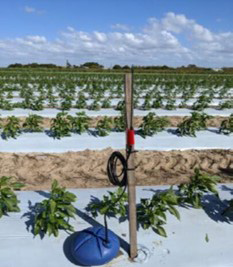BACKGROUND AND OBJECTIVES
 There is increasing pressure for horticultural industries in Queensland to manage phosphorus and limit inorganic nitrogen loads, which are difficult to measure and model. Runoff from farms drains into local catchments that eventually reach the ocean in coastal areas close to the Great Barrier Reef marine park.
There is increasing pressure for horticultural industries in Queensland to manage phosphorus and limit inorganic nitrogen loads, which are difficult to measure and model. Runoff from farms drains into local catchments that eventually reach the ocean in coastal areas close to the Great Barrier Reef marine park.
Nutrient pollution in marine parks can impact various aspects of sensitive reef ecosystems. In combination with climate change impacts, including extreme weather events, nutrient pollution is impacting the Reef’s resilience and recovery.
Hort Innovation Australia Ltd has established three pilot demonstration smart farms in the Great Barrier Reef catchment. These pilot farms incorporate four different crop management systems, including for banana, vegetable, avocado, and nursery crops. These smart farms use a digital dashboard to integrate sensor and other data to remotely monitor environmental performance and drive adoption of best management practice codes nationally. In addition, new technologies have been used to automatically collect and provide evidence for certification audits.
Remote technology has been used in the continuous monitoring of environmental indicators, such as nutrient leaching, sediment runoff, water and energy use efficiency, and more. These insights will guide best management practices around irrigation, fertilization, and plant care, and optimize horticulture practices for sustainable, environmentally- friendly food production.
ACTIONS
The project has leveraged data, artificial intelligence, advanced analytics, edge computing, and sensor technology to predict and prescribe actionable insights based on data algorithms. In the future, the project plans to incorporate machine learning, which is a type of artificial intelligence that will allow the project’s software applications to become more accurate at predicting outcomes without being explicitly programmed to do so.
Using the data, models are developed, including water balance, nutrient load, and growth, which are then fed into a digital control tower (web-based dashboard). The data is collected and interpreted remotely, reducing time spent on farm auditing.
The control tower holistically interprets productivity and environmental stewardship by integrating sensor data, weather forecasts, and biophysical models. The control tower also automates collection of data required in audit reports and provides growers with decision support tools for managing nutrient runoff, leaching, irrigation, and other management practices.
Specific technologies used to collect and collate data include:
- soil moisture testing
- weather station
- band Dendrometer
- nitrate sensor
- sap flow sensors
- leachate monitoring
- irrigation pressure transducers
- full stop wetting front detectors
- rated flumes
- pest cameras
- smartphone and tablet
 RESULTS
RESULTS
Using a digital dashboard to integrate sensor and other data remotely, farmers have been able to monitor environmental performance and implement responsive management practices to improve productivity while reducing costs and minimizing environmental footprint.
Social: Automating environmental reporting is freeing up time for farmers by reducing the time needed to manually monitor farms. This is allowing more time for farmers to plan and evaluate farm activities.
Environmental: Establishing remote monitoring and data analytics has reduced environmental runoff and leaching (including nitrate and sediment) into the neighboring environment and catchment areas by providing accurate and actionable management insights. Modelling of nitrate leaching has been tested by the delivery partners and outcomes of the model have been incorporated into the control tower. The ability to automate records regarding fertilizer application allows modelling of nitrate runoff and leaching to occur. The control tower now allows the user to understand risks of nitrate leaching and runoff so as to improve crop, fertilizer, and irrigation management to minimize any off-farm impacts.
This will improve surrounding water quality and reduce impact on the Barrier Reef marine park. The combined data is also improving the accuracy of environmental audits.
Economic: The technology installed on the pilot farms was designed to improve farm productivity, reduce costs, and simplify compliance with environmental regulations. Targeted data analysis assisted with improvements in labor efficiency by directing interventions and avoiding unnecessary management. Automated data reduced the time taken to manually collect data for audits. These factors will inevitably increase the profitability of farming systems.
SUCCESSES AND LESSONS LEARNED
Use of the digital control tower has led to immediate improvements in crop management across all sites, including water, fertilizer, and pesticide input. This has led to savings in water use, farm inputs, energy use, and labor time.
Future development is planned to allow mapping for nitrogen use against Reef regulations. The next phase is progressing from data insights to business solutions and final automation for selected systems such as irrigation.
Implementing this initiative in a number of pilot sites has allowed this technology to be tested under different management practices. This shows that the technology is robust and flexible and can be tailored to different production systems.
The use of the control tower to automatically complete environmental audit forms has been welcomed by farmers. This is reducing the labor input and improving the accuracy of reporting.

